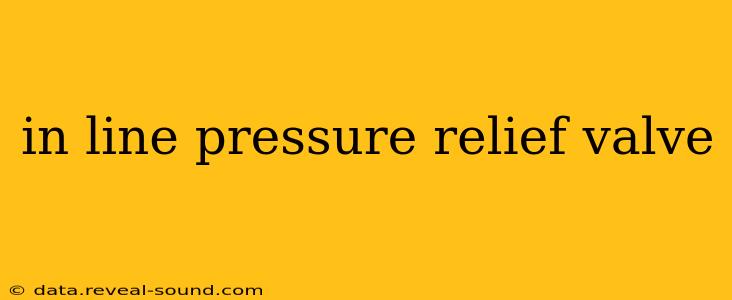In-line pressure relief valves are critical safety devices used in a wide range of industrial and commercial applications to protect systems from overpressure. These valves automatically open when the pressure in a system exceeds a predetermined setpoint, preventing damage to equipment and ensuring the safety of personnel. Understanding their function, selection, and maintenance is crucial for optimal system performance and safety.
What is an In-Line Pressure Relief Valve?
An in-line pressure relief valve, also known as a pressure relief valve (PRV) or safety relief valve (SRV), is a crucial component designed to automatically release excess pressure from a system when it surpasses a pre-set limit. Unlike other pressure-regulating devices, it's primarily a safety mechanism, not a precise pressure control device. Its key function is to protect the system from catastrophic failure due to excessive pressure build-up. These valves are typically installed directly in the pipeline, hence the term "in-line."
How Does an In-Line Pressure Relief Valve Work?
The operation is relatively straightforward:
-
Normal Operation: At normal operating pressures, the valve remains closed, maintaining the integrity of the system.
-
Pressure Increase: When the pressure in the system exceeds the pre-set pressure limit, the valve's internal mechanism activates. This typically involves a spring-loaded poppet or diaphragm that is forced open by the increased pressure.
-
Pressure Release: Once the valve opens, the excess pressure is released, relieving the stress on the system's components.
-
Pressure Decrease: When the system pressure drops below the setpoint plus a small reseat pressure, the valve automatically closes, restoring the system to its normal operating state.
What are the Different Types of In-Line Pressure Relief Valves?
Several types of in-line pressure relief valves exist, each suited for specific applications and pressure ranges:
-
Spring-Loaded Valves: These are the most common type, relying on a spring to maintain the closed position until the pressure exceeds the setpoint. They offer a simple, reliable design, suitable for various applications.
-
Pilot-Operated Valves: These valves utilize a pilot signal to control the main valve opening. They are generally used for larger systems or those requiring more precise pressure control.
-
Diaphragm Valves: These valves use a flexible diaphragm to isolate the system pressure from the actuating mechanism. They are particularly useful in applications involving corrosive or hazardous fluids.
What are the Applications of In-Line Pressure Relief Valves?
In-line pressure relief valves find applications across numerous industries, including:
-
Hydraulic Systems: Protecting hydraulic components from overpressure.
-
Pneumatic Systems: Ensuring safety in compressed air systems.
-
Chemical Processing: Preventing overpressure in reactors and pipelines handling chemicals.
-
HVAC Systems: Safeguarding HVAC equipment and preventing damage from overpressure.
-
Water Treatment: Protecting water treatment systems from excessive pressure.
How to Select the Right In-Line Pressure Relief Valve?
Choosing the appropriate valve involves several factors:
-
System Pressure: The maximum operating pressure of the system.
-
Flow Capacity: The amount of fluid the valve needs to discharge to relieve excess pressure.
-
Fluid Type: The properties of the fluid, including its viscosity, corrosiveness, and temperature.
-
Set Pressure: The pressure at which the valve is designed to open.
-
Material Compatibility: Ensuring the valve materials are compatible with the system's fluid and operating conditions.
What is the Importance of Regular Maintenance for In-Line Pressure Relief Valves?
Regular maintenance is paramount to ensure the reliability and safety of in-line pressure relief valves. This typically includes:
-
Periodic Inspection: Checking for leaks, damage, or corrosion.
-
Testing: Regular functional testing to verify the valve's ability to open and close at the correct pressure.
-
Cleaning: Removing any debris or buildup that might impede the valve's operation.
How Often Should I Test My In-Line Pressure Relief Valve?
The frequency of testing depends on several factors, including the application, industry regulations, and the manufacturer's recommendations. Consult the valve's specifications and relevant safety guidelines for specific testing intervals. Regular testing is critical for preventing unexpected failures and ensuring system safety.
What Happens if an In-Line Pressure Relief Valve Fails?
Failure of an in-line pressure relief valve can have serious consequences, potentially leading to equipment damage, system failure, and even personal injury. It's crucial to select appropriately sized and properly maintained valves to prevent such failures.
This comprehensive guide provides a thorough overview of in-line pressure relief valves. Remember that safety is paramount, and consulting with qualified professionals for selection, installation, and maintenance is strongly recommended.
